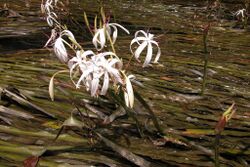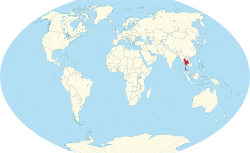Biology:Crinum thaianum
| Crinum thaianum | |
|---|---|

| |
| Scientific classification | |
| Kingdom: | Plantae |
| Clade: | Tracheophytes |
| Clade: | Angiosperms |
| Clade: | Monocots |
| Order: | Asparagales |
| Family: | Amaryllidaceae |
| Subfamily: | Amaryllidoideae |
| Genus: | Crinum |
| Species: | C. thaianum
|
| Binomial name | |
| Crinum thaianum J. Schulze[2]
| |

| |
| Crinum thaianum is endemic to Thailand[3] | |
Crinum thaianum, also called the Thai onion plant or water onion, is an emergent plant species, endemic to the coastal plain of Ranong and Phang Nga Provinces, Thailand.[2] Its natural habitat is to grow along the banks of flowing, medium- to fast-running streams, where its roots and bulb are submerged in the sediment, while its leaves grow long in the current and can access fresh air at the surface. When in bloom, the flower is an umbel of large, showy blossoms above the waterline. These growth habits make it a wonderful addition for tropical aquaria, and it is sold in many regions to be used specifically for growth within displays of tropical fish. It also serves the added benefit of oxygenating the water and absorbing ammonia, which is toxic to most aquatic animals.[4][5][6] In nature, however, the species is threatened with extinction, and diminishing rapidly, due to habitat destruction.[1]
Description
Long, up to 60 inches (150 cm) (or longer), tough, ribbon-like bright green leaves grow from a bulb that looks much like an onion. White lily-like flowers may form on a long stalk emerging above the water's surface.[2]
Etymology
The specific epithet thaianum refers to Thailand, this species’ country of origin.
Cultivation
Crinum thaianum is cultivated as an aquatic ornamental to decorate aquaria. It requires water temperatures of 72–86 degrees F (22–30 degrees C) and is popular in home aquaria because it is easy to keep, tolerant of temperature swings and lighting variations, and because its leaves are tough enough to withstand the attention of herbivorous fish. Propagation is from daughter bulbs. It likes a rich substrate and additional CO2 encourages growth with space to spread and grow. It does well in a warm outside pond.[7][8]
Status and threats
Crinum thaianum is not under protection by any legislation in Thailand and also not protected by CITES. The habitats of this species are also not under protection.[citation needed]
This species has remaining only 1% and found population very high fragmented and rapidly decreasing. In some habitats, it is already extinct due to collecting the bulb for commercial purposes, dredging under flooding control schemes, and land use changes. Currently, Crinum thaianum has been listed as Endangered under IUCN Redlist and Thailand Data Redlist. It is really urgent required for special management and conservation plan to reduce decrease and extinction.[citation needed]
References
- ↑ 1.0 1.1 Soonthornnawaphat, S.; Bambaradeniya, C.; Sukpong, P. (2011). "Crinum thaianum". IUCN Red List of Threatened Species 2011: e.T201627A9154955. doi:10.2305/IUCN.UK.2011-2.RLTS.T201627A9154955.en. https://www.iucnredlist.org/species/201627/9154955. Retrieved 11 November 2021.
- ↑ 2.0 2.1 2.2 Joachim Schulze. 1971. Plant Life 27: 127, Crinum thaianum
- ↑ "Crinum thaianum J.Schulze" (in en). Royal Botanic Gardens, Kew. http://www.plantsoftheworldonline.org/taxon/64089-1. Retrieved 23 July 2023.
- ↑ Tropica Aquarium Plants, plant details, Crinum thaianum
- ↑ Onion Plant
- ↑ Aqquarienpflanzenshop, Thailand-Wasserlilile, Crinum thaianum Zwiebel[yes|permanent dead link|dead link}}]
- ↑ Hiscock, Peter (2003). Encyclopedia of Aquarium Plants. United States and Canada: Interpret Publishing. ISBN 0-7641-5521-0.
- ↑ "Success with Onion Plants". http://www.aqualandpetsplus.com/Plant,%20Onion.htm.
Wikidata ☰ Q1619537 entry
 |


